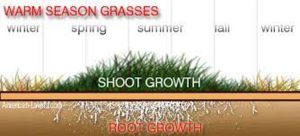I frequently get questions asking, “Why is this turfgrass turning brown?” The quick answer is that it depends, although that alone is not helpful. There are two reasons why turfgrass begins to yellow or get chlorotic, and in some cases continues to a straw or brown appearance.
Reason One
The first reason is due to natural physiological processes which can be compared to human circadian rhythms. Our physical, mental and behavior changes respond to light and dark which some refer to as our biological clocks. The same is true of plants including turfgrass. In the fall when the daylight hours shorten (less sunlight) and the temperatures drop, especially at night, plants naturally slow growth and transfer energy reserves to roots to promote healthy growth when the daylight hours lengthen, and temperatures increase in the spring.
Fluctuations in light and temperature influence photosynthesis and soil temperature, which in turn influences turfgrass root growth and the ability of plants to uptake nutrients. The shorter day lengths and cooler nighttime temperatures of winter months are a signal to warm season turfgrass that conditions are different from the warm summer season growth period. These conditions cause warm season turfgrass to go into semi-dormancy in central Florida.  Turfgrass photosynthesis and growth slows. Turfgrass will naturally become less “green” and will slough off 40-60% of its root material. See the turfgrass growth curve diagram and note the seasonal differences in color as well as root density. In spring (March-May), when the days become longer and soil temperatures are warmer, turfgrass will naturally regrow a dense root system and green up.
Turfgrass photosynthesis and growth slows. Turfgrass will naturally become less “green” and will slough off 40-60% of its root material. See the turfgrass growth curve diagram and note the seasonal differences in color as well as root density. In spring (March-May), when the days become longer and soil temperatures are warmer, turfgrass will naturally regrow a dense root system and green up.
The less dense and shorter root system in the cooler months cannot uptake nutrients as readily, and as a result, nutrients applied during winter months may leach into groundwater or run off with irrigation or rain. Additionally, the roots are not able to support lush shoot growth and turfgrass may deteriorate over time. Have you had turfgrass that has persistent or repeated disease issues year after year or replaced turfgrass every 3-5 years because it fails to thrive or meet your client’s expectations?
If so, consider the fertilization practices and look at the roots. The roots should be creamy in color, not dark and stubby. Think of turfgrass as a marathon runner:
- The typical marathon runner will train intensely, eat more calories and perform well (the spring to fall warm growing season)
- And, rest, recuperate and consume less calories between marathons (the late fall and winter cool season)
- If a marathon is run every week with no rest or recuperation, they will not be able to recover or regain strength properly. Something will fail which may be the knees, ankles, feet, or hips (lush turfgrass shoot growth during cool seasons is at the expense of the root system, hence increased disease issues).
- Warm season turfgrass should not be fertilized from mid-November through mid-March in central Florida.
UF/IFAS Extension has specific fertilization guidelines for the appropriate amount of fertilizer to apply and the time of year to make fertilizer applications to turfgrass. The challenge is accepting that turfgrass naturally wants to be off color during the winter months and that even in Florida our plants need a rest from vigorous growth to enable healthy growth during the active growing season. Keep in mind that much like a bear hibernates, plants slumber for several months once the cooler temperatures of winter arrive. Fertilizer applications during the cooler months, which promote lush green grass in the winter months, increase susceptibility to disease and insect issues, and contribute to decreased water quality.
Reason Two
This brings me to the second reason turfgrass becomes yellow, straw or brown in color. Stressed turfgrass is more susceptible to disease, insect and weed pressures. Conditions that can promote stress include too much water (irrigation or rain), too little water (drought or malfunctioning irrigation system), too much or too little fertilization, wrong timing of fertilization, improper fertilizer or pesticide applications, improper mowing practices, lack of sunlight (too much shade), and extreme weather conditions. Over irrigation and over fertilization are the two main contributors to turfgrass disease, insect and weed problems.
When you call me and ask why the turfgrass is turning brown, I will in turn ask a lot of questions about how your stand is and has been managed. I may ask you to email photographs, bring in a sample or to schedule a site visit. You may need to send a sample to a plant diagnostic lab. There is no easy answer or quick solution to properly diagnosing turfgrass problems. If you ever quickly tell your clients, it’s this or that and I’ll do this or that without a proper diagnosis you are wasting your time and their money, and potentially making applications that may lead to environmental degradation. So, if the turfgrass is turning brown, contact your local UF/IFAS Extension office for assistance and recommendations on proper management. The UF/IFAS Extension Hillsborough County Office can be reached at (813)744-5519.
 7
7
